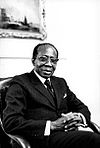സെറർ ജനത
സെറർ ജനത ഒരു പടിഞ്ഞാറൻ ആഫ്രിക്കൻ വംശീയ മത വിഭാഗമാണ്.[4][5] സെനഗലിലെ മൂന്നാമത്തെ വലിയ വംശീയ വിഭാഗമായ അവർ, സെനഗലിലെ ആകെ ജനസംഖ്യയുടെ ഏകദേശം 15 ശതമാനംവരുന്നു.[6] വടക്കൻ ഗാംബിയയിലും തെക്കൻ മൗറിത്താനിയയിലും ഈ ജനത കാണപ്പെടുന്നു.[7] സെനഗലിന്റെയും മൗറിത്താനിയയുടെയും അതിർത്തിയിലുള്ള സെനഗൽ നദീതടത്തിൽ നിന്ന് ഉത്ഭവിച്ച സെറർ ജനത 11, 12 നൂറ്റാണ്ടുകളിൽ തെക്കോട്ട് നീങ്ങുകയും പിന്നീട് 15, 16 നൂറ്റാണ്ടുകളിൽ അവരുടെ ഗ്രാമങ്ങൾ ആക്രമിക്കപ്പെട്ടതോടെ മതപരമായ സമ്മർദ്ദങ്ങൾക്ക് വിധേയരാകുകയും ചെയ്തു.[8][9][10]
  | |
| Total population | |
|---|---|
| Over 1.8 million[1] | |
| Regions with significant populations | |
| ഫലകം:Country data സെനഗൽ | 1.84 million |
| 53,567[2] | |
| 3,500 | |
| Languages | |
| സെറർ, കാൻഗിൻ ഭാഷകൾ, വോലോഫ്, ഫ്രഞ്ച്(Senegal and Mauritania), ഇംഗ്ലീഷ്(Gambia) | |
| Religion | |
| Senegal 2002: 90% Islam, 9% Christianity[3] and Serer religion (ƭat Roog) | |
| ബന്ധപ്പെട്ട വംശീയ ഗണങ്ങൾ | |
| വോൾഫ് ജനത, ജോല ജനത, ടൗകോളർ ജനത, and ലെബൂ ആളുകൾ | |
അവലംബം
തിരുത്തുക- ↑ Agence Nationale de Statistique et de la Démographie. Estimated figures for 2007 in Senegal alone
- ↑ National Population Commission Secretariat (30 April 2005). "2013 Population and Housing Census: Spatial Distribution" (PDF). Gambia Bureau of Statistics. The Republic of The Gambia. Archived (PDF) from the original on 3 January 2018. Retrieved 29 December 2017.
- ↑ Claire L. Adida; David D. Laitin; Marie-Anne Valfort (2016). Why Muslim Integration Fails in Christian-Heritage Societies. Harvard University Press. pp. 33–34. ISBN 978-0-674-50492-9.
- ↑ "Charisma and Ethnicity in Political Context: A Case Study in the Establishment of a Senegalese Religious Clientele", Leonardo A. Villalón, Journal of the International African Institute, Vol. 63, No. 1 (1993), p. 95, Cambridge University Press on behalf of the International African Institute
- ↑ Villalón, Leonardo A., Islamic Society and State Power in Senegal: Disciples and Citizens in Fatick, p. 62, Cambridge University Press (2006), ISBN 9780521032322
- ↑ Senegal, CIA Factsheet
- ↑ [1] Ethnologue.com
- ↑ Galvan, Dennis Charles, The State Must Be Our Master of Fire: How Peasants Craft Culturally Sustainable Development in Senegal Berkeley, University of California Press, 2004 p. 51
- ↑ Elizabeth Berg; Ruth Wan; Ruth Lau (2009). Senegal. Marshall Cavendish. p. 63. ISBN 978-0-7614-4481-7.
- ↑ Leonardo A. Villalón (2006). Islamic Society and State Power in Senegal: Disciples and Citizens in Fatick. Cambridge University Press. pp. 54–55. ISBN 978-0-521-03232-2., Quote: "Serer oral tradition recounts the group's origins in the Senegal River valley, where it was part of, or closely related to, the same group as the ancestors of today's Tukulor."